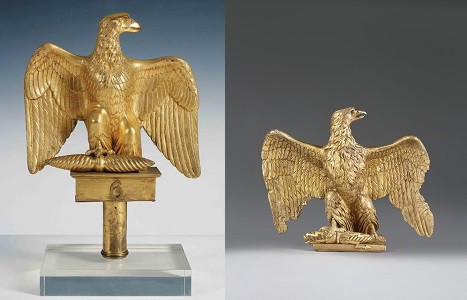In the decree of 10 July 1804, Napoleon I stipulated that the new imperial coat of arms should be “d’azur à l’aigle à l’antique d’or, empiétant un foudre du même” (“azure, with an eagle in the manner of antiquity, coloured gold, clutching in its talons a thunderbolt of the same colour”). After the proclamation of the Empire, this “eagle in the manner of antiquity” was quickly incorporated into the imperial symbolism, alongside the eagle of Charlemagne. In the manner of Roman legions, Napoleon had an eagle placed on the top of the flagstaff of each of his regiments. A ceremony to mark the distribution of these “eagles” took place on the Champ de Mars, in front of the École Militaire. The ceremony was held on 5 December 1804, a sort of military equivalent of the coronation ceremony.
The flagstaff eagles of the First Empire were cast in gilded bronze by Pierre-Philippe Thomire (1751-1843), based on a drawing by Antoine-Denis Chaudet (1763-1810). Their heads are turned to the right, whilst their wings are slightly unfurled, and their talons clasp Jupiter’s thunderbolt. They are mounted on a small plinth which bears the number of the regiment to which they belong. During the First Empire, there were three successive models. The first and most majestic model, created in 1804, was quickly found to be too heavy. It was replaced by a lighter model around 1810. Later, during the Hundred Days, a final version just like the one seen here (on the left) was created to compensate for the loss of some eagles during the Restoration. The eagle is more compact, with the beak almost closed. This particular flagstaff eagle belonged to the 6e Régiment de Chasseurs à Cheval [6th mounted regiment], which participated notably in the Russian, German, French and Belgian Campaigns. During the Second Empire, this regiment took part in the Battle of Sedan on 1 September 1870.
From 31 December 1851, Napoleon III decided to re-use his uncle’s symbols, placing eagles at the top of every regimental flagstaff. Another ceremony for the distribution of “eagles” was organised, on 10 May 1852, after the coup d’état of 2 December 1851, but before the referendum that publicly sanctioned the Empire in November 1852. Indeed, the ceremony was of the utmost political importance, since it gave the future Emperor an opportunity to gauge the loyalty of his army. For this event, representatives were summoned from every garrison in France and Algeria. The actual eagles, designed by Jean-Auguste Barre (1811-1896) and cast in gilded bronze, once again had unfurled wings and an open beak. In all, there were three models that would be realised during the course of the Second Empire. Indeed, Napoleon III himself asked smelters to reduce considerably the weight of the eagles, firstly in line with technological advances but also with the aim of enhancing his solders’ well-being. In 1854, an eagle created using an electroplating technique (in other words, the application of a thin coating of metal to another metallic surface though an electrochemical process called “galvanoplastie”) was proposed to the Emperor. Finally, in 1860, the foundry master Michel-Ange Marion offered an eagle made from an aluminium-bronze alloy and then gilded. The weight was reduced to no more than a kilo. The imperial Eagle seen here is an example of this final model. The aluminium-bronze is slightly visible beneath the gold-plate, which gives this eagle a rose-coloured tint. Research has allowed us to establish, with almost complete certainty, that this eagle here was one that belonged to the 45th Infantry regiment. During the Second Empire, this regiment participated notably in the Battle of Magenta on 4 June 1859.
Elodie Lefort, March 2018 (English translation Jenny Spencer with RY and PH)
Images : from left to right:
Flagstaff Eagle of the 6e régiment de chasseurs à cheval, Model 1815
Pierre-Philippe THOMIRE, founder (1751-1843), after Antoine-Denis CHAUDET (1763-1810)
1815
Gilded bronze
INV 895, Fondation Napoléon, Paris
© Fondation Napoléon, Patrice Maurin-Berthier
Flag eagle, aluminium model
Michel-Ange MARION (founder), after Jean-Auguste BARRE (1811-1896)
1860
gilded Aluminium-bronze
INV 262, Fondation Napoléon, Paris
© Fondation Napoléon, Thomas Hennocque


